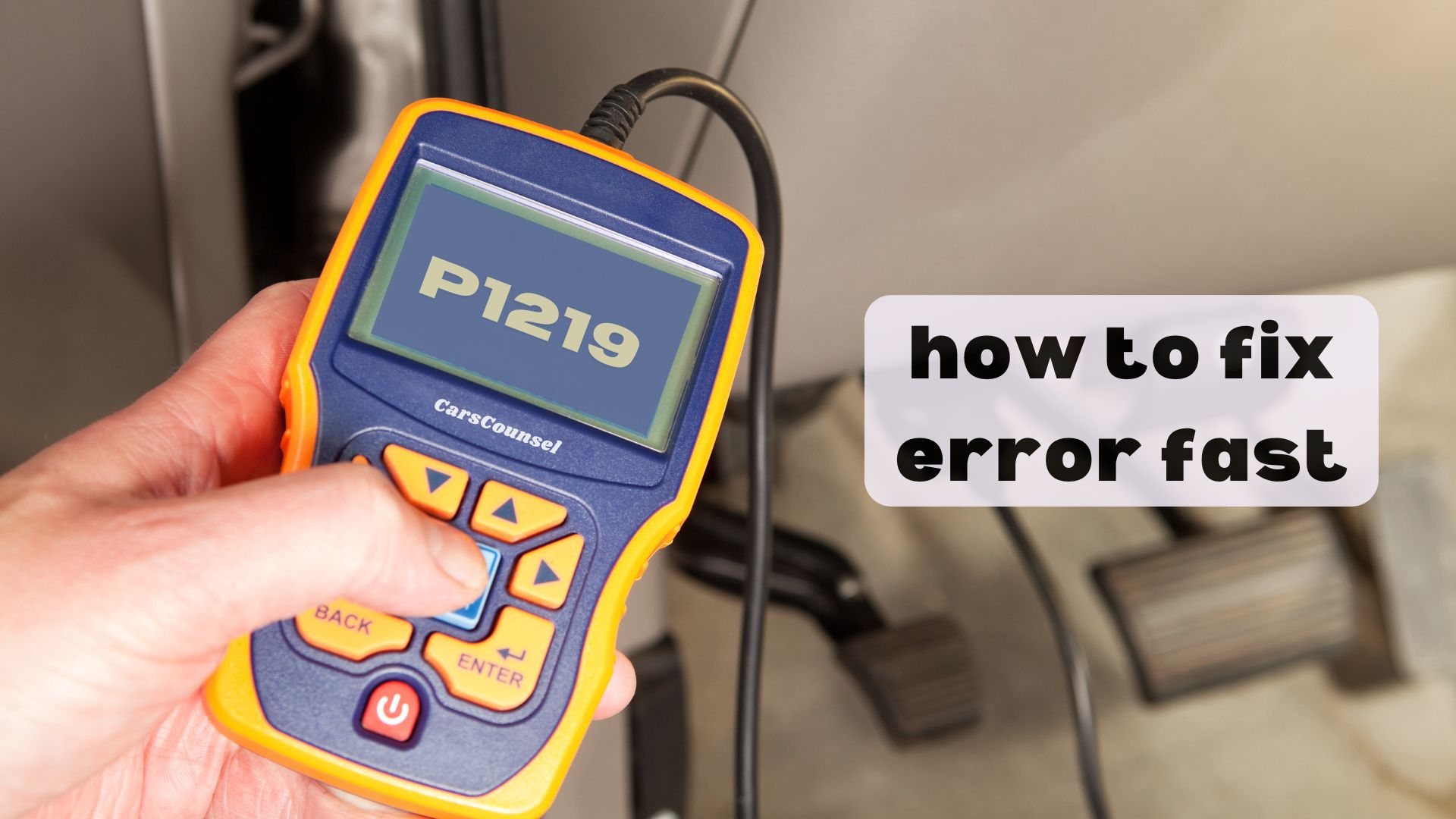You’re driving on the highway when your car’s Check Engine Light suddenly illuminates, and the engine starts misfiring. A quick scan of the onboard diagnostics reveals a P1219 code, indicating the Control Input Device (CID) is stuck in a low voltage state. This sensor plays a critical role in regulating throttle input, ignition timing, and fuel delivery, so it’s essential to address the issue promptly. But what’s causing the CID to malfunction, and how can you get your engine running smoothly again?

Quick Navigation
Key Takeaways
- A P1219 code indicates the Control Input Device (CID) is stuck in a low voltage state, affecting engine performance and fuel efficiency.
- Sensor corrosion, wiring faults, or environmental factors can cause the CID to stick low, leading to poor engine performance and decreased fuel efficiency.
- Symptoms of a faulty CID sensor include engine misfires, rough idling, decreased fuel efficiency, and the Check Engine Light being illuminated.
- To diagnose the issue, consult the vehicle’s repair manual, take voltage readings, and check for corrosion, damage, or wiring issues.
- Replace the CID sensor with an OEM-approved unit if necessary, and perform regular sensor maintenance to prevent future issues.
Understanding the P1219 Code
When your vehicle’s onboard computer generates a P1219 code, it’s indicating that the Control Input Device (CID) is stuck in a low voltage state, which can significantly impact engine performance and fuel efficiency.
This critical component in your vehicle’s electronic control system regulates throttle input, ignition timing, and fuel delivery. As a key sensor, the CID’s low voltage state can lead to poor engine performance, decreased fuel efficiency, and potential damage to engine components if not addressed promptly.
Regular sensor maintenance is vital to prevent such issues, ensuring your vehicle’s electronics operate smoothly and efficiently.
Causes of CID Stuck Low
As you delve into the root cause of the P1219 code, it’s essential to identify the factors contributing to the CID stuck low condition.
Sensor corrosion is a common culprit, as it can compromise the sensor’s ability to send accurate signals to the ECM. Wiring faults, such as frayed or damaged wires, can also lead to a low voltage signal, causing the CID to stick low.
Additionally, wiring connections that are loose or corroded can disrupt the signal, resulting in the P1219 code. Identifying and addressing these underlying issues is vital to resolving the CID stuck low condition.
Symptoms of a Faulty CID Sensor
Faulty CID sensors can manifest in various ways, affecting your vehicle’s performance and overall driving experience.
When a CID sensor fails, it can cause voltage drops, leading to a range of symptoms.
You may notice:
- Engine misfires or hesitation during acceleration
- Rough idling or stalling
- Decreased fuel efficiency
- The Check Engine Light illuminated on the dashboard
These symptoms can be indicative of sensor failure, and it’s essential to address the issue promptly to prevent further damage to your vehicle’s engine.
Diagnosis and Testing Procedures
To diagnose and test for a P1219 code, you’ll need to follow a structured approach to identify the root cause of the issue. Start by consulting your vehicle’s repair manual to locate the CID sensor and its wiring. Then, use a multimeter to take voltage readings at the sensor to determine if it’s consistently reading low.
| Test | Expected Result |
|---|---|
| Multimeter reading at CID sensor | 4.5-5.5V (depending on vehicle make and model) |
| Sensor troubleshooting | Check for corrosion, damage, or wiring issues |
| ECM communication test | Verify proper communication between ECM and CID sensor |
Repairing the CID Stuck Low Issue
When tackling the repair of a CID stuck low issue, you’ll need to methodically address each potential cause to guarantee a thorough fix.
Start by conducting a thorough visual inspection of the CID sensor, wiring, and connections for any signs of damage or corrosion.
Perform Sensor Maintenance tasks, such as cleaning the sensor and checking for debris intrusion.
Then, move on to CID Troubleshooting procedures to identify the root cause of the issue.
- Check the CID sensor’s voltage output using a multimeter to determine if it’s consistently reading low.
- Inspect wiring and connections for signs of damage or corrosion.
- Check the ECM for any malfunction or software issues.
- Perform a system reset to certify all components are communicating correctly.
Replacing the CID Sensor
One faulty CID sensor can throw your entire engine off kilter, so it’s crucial to replace it with a new, OEM-approved unit if testing reveals it’s stuck low.
When selecting a replacement sensor, prioritize sensor quality to guarantee accurate readings and reliable performance.
Installation tips include verifying the new sensor is properly seated and secured, and that all wiring and connections are clean and free of corrosion. Follow the manufacturer’s instructions for installation and calibration to guarantee a seamless integration with your vehicle’s electronic control system.
Preventing Future Occurrences
Regular maintenance and inspections can help prevent the P1219 code from occurring again in the future.
By taking proactive steps, you can avoid costly repairs and guarantee your vehicle runs smoothly.
To prevent future occurrences, make sure to:
- Perform routine checks on your vehicle’s electrical system to catch any potential issues early
- Keep your CID sensor clean and free from debris
- Avoid exposing your vehicle to extreme temperatures or moisture
- Follow the recommended maintenance schedule outlined in your vehicle’s manual
Estimated Repair Costs and Resources
About $150 to $400 is what you can expect to pay to fix a P1219 CID Stuck Low code, including parts and labor.
These repair estimates can vary depending on your vehicle’s make and model, the location of the repair shop, and the specific diagnosis and repair procedures required.
To get an accurate estimate, consult with a trusted mechanic or repair shop. They’ll use diagnostic tools to identify the root cause of the issue and provide a detailed breakdown of the costs involved.
More OBD-II Codes
| P1220 | P1228 | P1234 | P1237 |
| P1231 | P1240 | P1250 | P1286 |
| P1287 | P1288 | P1305 | P1395 |
| P1310 | P1394 | P1390 | P1396 |
| P1371 | P1370 | P1368 | P1367 |
| P1366 | P1365 | P1364 | P1363 |
Frequently Asked Questions
Can I Drive My Car With a P1219 Code?
You can drive your car, but be aware that a stuck low CID sensor may cause poor fuel efficiency and affect engine performance, potentially leading to further damage; it’s recommended to address the issue promptly to avoid driving restrictions.
Will a P1219 Code Cause My Car to Fail an Emissions Test?
When your car’s idle malfunction is causing emissions failure, it’s likely you’ll fail the test; and, yes, a stuck CID sensor can be the culprit, leading to poor engine performance and increased emissions, ultimately resulting in a failed test.
Can a Faulty Oxygen Sensor Trigger a P1219 Code?
You’re wondering if a faulty oxygen sensor can trigger a P1219 code. While unlikely, a malfunctioning oxygen sensor can cause issues that indirectly affect the CID, leading to a stuck low signal, especially if it’s causing fuel injector clogging or sensor malfunction.
Is a P1219 Code More Common in Certain Vehicle Models?
You’ll find that certain vehicle models, particularly those designed for cold climates or featuring specific engine designs, are more prone to experiencing issues with the CID sensor, making them more likely to trigger a P1219 code.
Will a Tune-Up or Oil Change Fix a P1219 Code?
You’re wondering if a tune-up or oil change will fix a P1219 code. Unfortunately, no, as these routine maintenance tasks won’t address the underlying issue with the CID sensor, fuel injector, or spark plug, which require specific diagnosis and repair.
Conclusion
As you shift into gear, don’t let a stuck CID sensor stall your journey. Fixing the faulty sensor frees your fuel efficiency from frustrating fluctuations. Faultless fuel flow and firing sequences follow, and your engine’s fiery performance is fully restored. By following these fix-it steps, you’ll finesse the p1219 code and forge a fresh path to peak performance.

